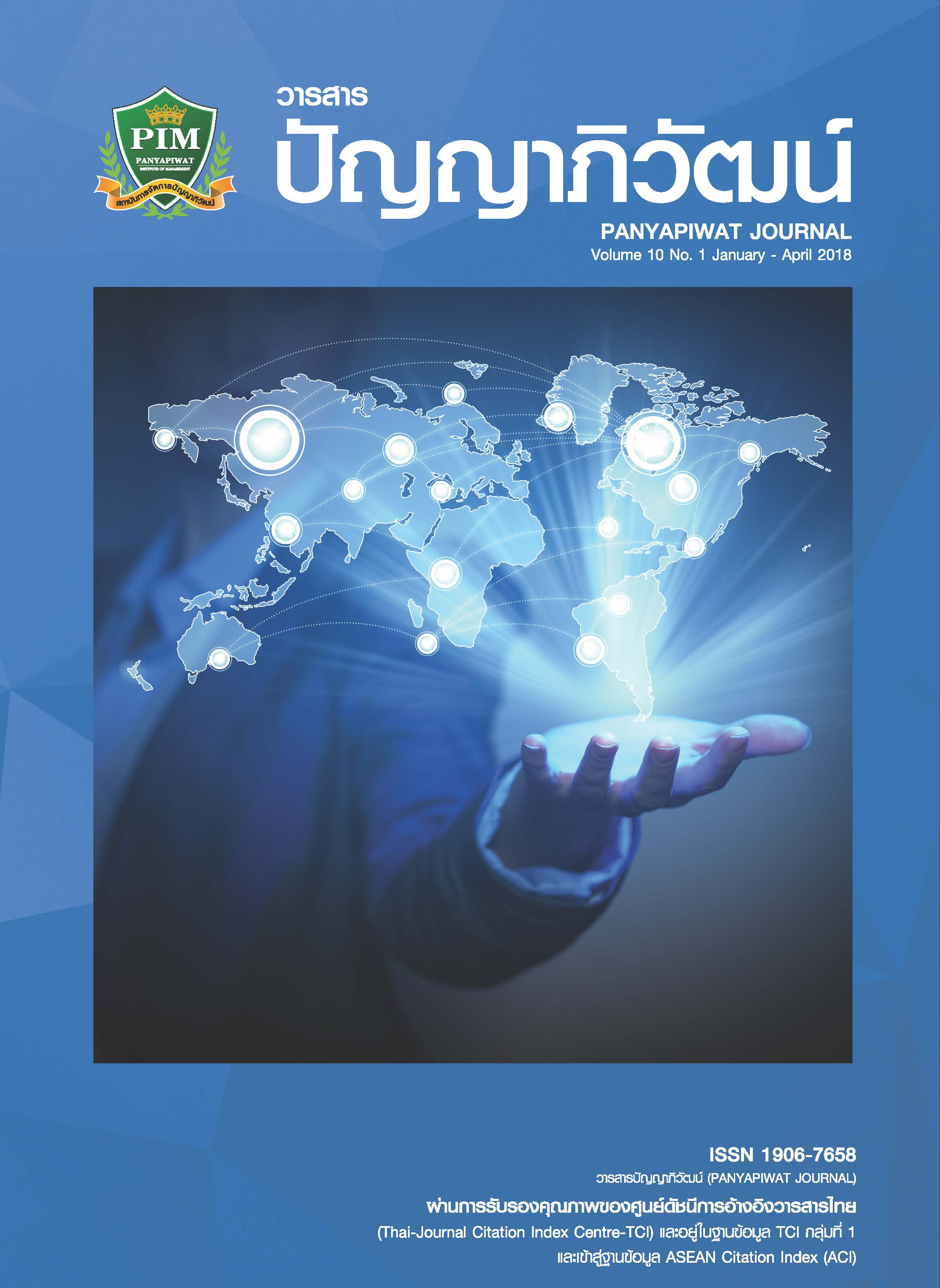การจัดการห่วงโซ่อุปทานที่เป็นมิตรต่อสิ่งแวดล้อมของอุตสาหกรรมฟอกย้อมในประเทศไทย
Main Article Content
บทคัดย่อ
ปัจจุบันนี้ผู้ประกอบการส่วนใหญ่ให้ความสำคัญกับการดำเนินกิจการที่คำนึงถึงการเป็นมิตรต่อสิ่งแวดล้อม การขับเคลื่อนแนวคิดการเป็นมิตรต่อสิ่งแวดล้อมสู่อุตสาหกรรมสีเขียวจึงถือเป็นองค์ประกอบหลักของการสร้างความสามารถเชิงการแข่งขันในยุคของอุตสาหกรรมสมัยใหม่ อุตสาหกรรมฟอกย้อมเป็นกระบวนการผลิตโดยใช้วัตถุดิบจากกระบวนการอุตสาหกรรมสิ่งทอต้นน้ำ วัตถุดิบทางด้านเคมี และวัตถุดิบด้านพลังงาน ผ่านกระบวนการผลิตให้เป็นผลิตภัณฑ์ใหม่ด้วยการฟอกย้อม ซึ่งเป็นกระบวนการอันส่งผลกระทบต่อสิ่งแวดล้อมโดยตรง บทความนี้นำเสนอวิธีการประยุกต์ใช้ตัวแบบ SCOR Model ในการจัดการห่วงโซ่อุปทานที่เป็นมิตรต่อสิ่งแวดล้อม ในขั้นตอน 1) การวางแผน 2) การจัดหาวัตถุดิบ 3) การผลิต 4) การจัดส่ง และ 5) การส่งคืน เพื่อลดผลกระทบต่อสิ่งแวดล้อมและนำไปสู่การพัฒนาเสริมสร้างความสามารถทางการแข่งขันของอุตสาหกรรมฟอกย้อมในประเทศไทยอย่างยั่งยืนต่อไป
Most entrepreneurs of the new industrialized era run their businesses with an environmental friendly mindset, integrating both competitive activities and environmental friendly concept in moving toward the green society. The manufacturing process of dyeing industry in Thailand requires inputs such as raw materials from upstream industrial process, chemical raw material and energy raw material and reproduces these inputs into a new product of the dyeing process. As the process directly affects the environment, supply chain management should be adopted as a tool that enabling environmental friendly aspect of the industry. This article presents the method of applying SCOR Model to an environmental friendly supply chain management covering the processes of planning, sourcing, manufacturing, delivering and product returning, all aiming for environmental impact reduction and developing sustainable competitiveness of dyeing industry in Thailand.
Article Details
“ข้าพเจ้าและผู้เขียนร่วม (ถ้ามี) ขอรับรองว่า บทความที่เสนอมานี้ยังไม่เคยได้รับการตีพิมพ์และไม่ได้อยู่ระหว่างกระบวนการพิจารณาลงตีพิมพ์ในวารสารหรือแหล่งเผยแพร่อื่นใด ข้าพเจ้าและผู้เขียนร่วมยอมรับหลักเกณฑ์การพิจารณาต้นฉบับ ทั้งยินยอมให้กองบรรณาธิการมีสิทธิ์พิจารณาและตรวจแก้ต้นฉบับได้ตามที่เห็นสมควร พร้อมนี้ขอมอบลิขสิทธิ์บทความที่ได้รับการตีพิมพ์ให้แก่สถาบันการจัดการปัญญาภิวัฒน์หากมีการฟ้องร้องเรื่องการละเมิดลิขสิทธิ์เกี่ยวกับภาพ กราฟ ข้อความส่วนใดส่วนหนึ่งและ/หรือข้อคิดเห็นที่ปรากฏในบทความข้าพเจ้าและผู้เขียนร่วมยินยอมรับผิดชอบแต่เพียงฝ่ายเดียว”
เอกสารอ้างอิง
Boonit, S. (2015). An Excellent Supply Chain Management. Bangkok: Faculty of Commerce and Accountancy, Thammasat University. [in Thai]
Chantanaroj, S. (2010). The SCOR Model Application for Performance Evaluation of Plastic recycles manufacturing: Case study of the plastic recycles manufacturing. University of the Thai Chamber of Commerce Journal, 30(4), 59-76. [in Thai]
Chatanawin, A. (2015). Direction of the 12th National Economic and Social Development Plan. Retrieved October 8, 2016, from http://www.thaitextile.org/index.php/blog/2015/12/thti28 [in Thai]
Department of Drainage and Sewerage. (2005). Best Practices of Pollution Prevention and Reduction for the Dyeing Industry. Bangkok: Pollution Control Department. [in Thai]
Department of Industrial Works. (2009). Pollution problems from the textile industry. Retrieved December 11, 2016, from http://www.thaiwasteexchange.net/detail_knowledge.php?kid=37 [in Thai]
Department of Industrial Works. (2009). The impact of the textile industry on the environment. Retrieved December 11, 2016, from http://thaiwasteexchange.net/detail_knowledge. php?kid=36 [in Thai]
Department of Primary Industries and Mines. (2015). Green supply Chain Logistics Management: Change and Innovation in Future Business. Bangkok: Charansanitwong Printing. [in Thai]
Gilbert, S. (2001). Greening supply chain: enhancing competitiveness through green productivity. Taiwan: International Green Productivity Association. Gromjit, P. (2014). Productivity Improvement: Principle and Practice. Bangkok: Se-Education. [in Thai]
Handfield, R. B. & Nichols, E. L. (1999). Introduction to supply chain management. NJ: Prentice-Hall.
Husby, P. (2007). Know the SCOR. Material Handling Management, 62(6), 16-18.
Industrial Waste Management Bureau. (2012). 3Rs Guide to Waste Management in a Plant. Bangkok: Department of Industrial Works. [in Thai]
Loasomboon, P. (2016). Clever use of smart labels with carbon-conscious world. Bangkok: Thailand Greenhouse gas Management Organization (Public Organization). [in Thai]
Mentzer, J. T., Dewitt, W., Keebler, J. S. Min, S. Nix, N. W., Smith, C. D. & Zacharia, Z. G. (2001). Defining Supply Chain Management. Journal of Business Logistics, 22(2), 1-25.
Pasatika, S. (1999). Techniques to reduce pollution from the source. Factory Journal, 17(3), 33-41. [in Thai]
Phoorung, S. (2016). Cost Management to Export Performance of the Apparel Business in Bangkok. The 1st National Conference on Informatics, Agriculture, Management, Business administration, Engineering, Sciences and Technology, May 19-21, 2016, King Mongkut's Institute of Technology Ladkrabakg, Prince of Chumphon. [in Thai]
Seeboonreang, A. (2016). The development of the textile and apparel industry in the form of a cluster. Thai Textile and Fashion Outlook, 18, 6-7. [in Thai]
Simchi-Levi, D., Kaminsky, P. & Simchi-Levi, E. (2000). Designing and Managing The Supply Chain. New York: McGraw-Hill Press.
Srivastava, S. K. (2007). Green supply-chain management: a State-of-the-art literature review. International Journal of Management Reviews, 9(1), 53-80.
Thailand Textile Institute. (2000). Cleaner Technology. Retrieved September 15, 2016, from http://www.thaitextile.org/index.php/blog/2016/06/Ebook_0206201601 [in Thai]
Tragoolhirunphadung, W. (2014). Health Check on Thai Textile and Garment Industry. For Quality, 21(202), 16-18. [in Thai]
Zsidisin, G. A. & Siferd, S.P. (2001). Environmental purchasing: a framework for theory development. European Journal of Purchasing & Supply Management, 7(1), 61-73.


